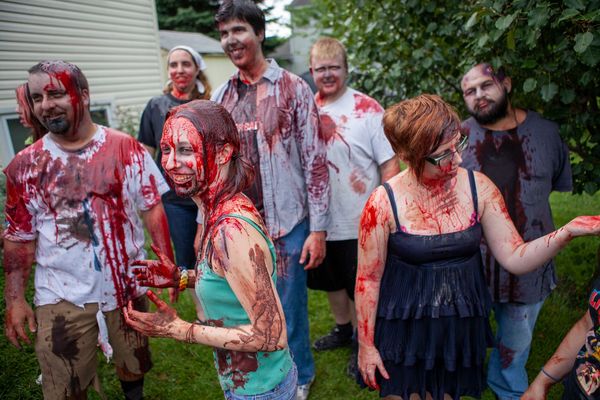 |
| The Brilliant Terror Photo: courtesy of Frightfest |
There’s no business like show business, and increasingly, when it comes to horror, everybody gets to have a go. Julie Kauffman and Paul Hunt’s documentary The Brilliant Terror, which is screening as part of Frightfest 2021, is a tribute to the art of low budget (or no budget) filmmaking, meeting groups of people so determined to bring their ideas to the screen that they go out and do it themselves, often using amateur actors, borrowed locations and whatever special effects gear they can pick up cheap at the local supermarket.
What is it that drives these people? How do they make it all happen? There’s a huge amount to explore here. In the run-up to the festival, Julie shared her thoughts on the film and began by reflecting on how it evolved during production.
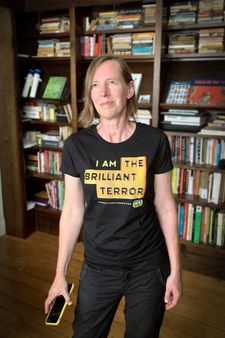 |
| Julie Kauffman |
“When we started out we were looking for unique voices, for people with something distinctive to say about that kind of grassroots, do it yourself, no budget, almost community of horror filmmakers,” she says. “But it was sort of one of those things where once we talked with one person, we'd ask ‘Who do you know, who do you recommend?’ And we were looking for the unknown, or yet to be known. People that are making movies by whatever means that they have.”
This effort to investigate new territory meant actively avoiding big names.
“We didn't want the usual suspects,” she says. “We wanted to hear things that we hadn't heard before, or different points of view, or see things that we hadn't seen before, and really concentrate on that grassroots side of things, where it really is like, low, low, low microbudgets. So in the process we did interview Ed Sanchez, from The Blair Witch Project, but decided against using much of that because we wanted to concentrate more on the unknown. It was a process of discovery.
She and Paul both work for nonprofits and NGOs, she explains, doing work with disaster recovery and storytelling which involves a lot of travel. “So whenever we would be travelling across the country to a different location, we would look up, ‘Hey, are there any horror filmmakers in this community that might be of interest?’ We were going to Mississippi one time and heard about Micah Ginn, who was making a werewolf movie. And we would discover, in small towns or big cities across the country, a kind of hidden hoard of little communities. But we also wanted to cover the spectrum of sub genres of horror, and not just one type of horror.”
The film isn’t all about lauding filmmakers’ efforts, however. It goes beyond a simple celebration of low-budget filmmaking and also incorporates some critical perspectives.
“We wanted to present some of those different viewpoints, and ones that we may not necessarily gravitate towards, leaving it up to the viewer how to take that,” she says. “It's been interesting, as different people watch it – they are attracted to different people in the movie or connect with them or are offended by them. Our approach is not highly confrontational but we also didn't want to shy away from raising some of those some of those issues.”
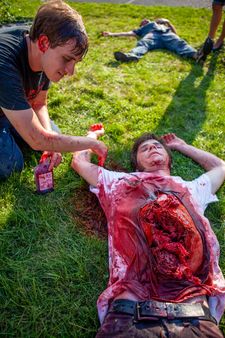 |
| The making of a massacre |
Those issues include the exploitation that exists at the impoverished end of the industry just as it exists at the top.
“Right. And I think that's a very good point because some of the stars that are involved in the #MeToo movement have talked about that, you know, this is happening in every office, in every work situation. And in the same way, it’s in the grassroots level of filmmaking, just the same. So we wanted to touch on that. But that wasn't the full focus of the movie, obviously – it could be a documentary in and of itself. And it felt like our our documentary touches on some of these different areas that you could do a deep dive into, and it gets people talking about things.”
It also explores some of the reasons why people are attracted to horror.
“Yeah, a lot of the films that people make are very personal. They're putting their personal fears, a lot of times, onto the screen. And I think they find validation for what they're doing and just an understanding of being human. That this is the form that it takes for them. Even with the fans as well. Scott Jeune talks about how for him it was sort of the antidote for his personal trauma, and being able to identify with the monsters in the movie. Feeling misunderstood and finding connection. And that's always an intriguing thing to me is, is how and where people find those very human things, to find connections.”
And there's that connection within the filmmaking teams as well, partly because it's such hard work doing that kind of cinema and people are having to really push themselves.”
She nods. “Yes, some of it is. One of the fun aspects for me was just the absolute joyous giddiness when things would come together, or, you know, ‘The blood cannon worked, and I only spent $300 on it, and the effect is like amazing!’ And then you have that contrast with the almost self induced torture of lying on that cold bathroom floor. And just like, ‘I don't like the shot.’ ‘Yeah, let's do it again.’ Like, how much torture do you put yourself through to make your creative vision come to life?”
Did people try to rope them in to help with things when they were there?
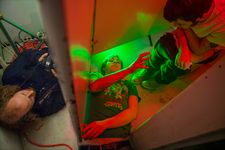 |
| On the set of The Stall |
“I think so my, my co director and producer Paul is my husband. He was doing a lot of the filming on the stalls [in the aforementioned bathroom scene]. And the only time he crossed the line, not just being an observational filmmaker, was that time where it was below freezing in there, it was so cold. And Mike [Lombardo] was literally shivering, and he's lying there on the floor and the fog machine is going and the fog machine is leaking onto the floor. And so he's getting wet on the floor in the cold. And and Paul was like, ‘You have to take care of yourself,” and he actually lay on top of Mike to warm him up in that shot.”
That scene features some great low budget special effects. There's some fascinating stuff in the film about that – the things that people have worked out from scratch and the sort of the secrets that people tell us that they keep.
“Yeah. with Mike particularly, he's all self taught. He's both a special effects person and a writer. He's like, the full package. But like he says in the film, you know, you can learn so much from behind the scenes videos and online, but then you get to a certain point where people don't want to share anymore the secrets of how they do things. And so I think a lot of it, he ended up figuring out for himself, and it has that DIY aspect to it. That's a fun element also.
“I would say that we weren't necessarily looking for filmmakers who were masters of what they did. What we did uncover was some real gems there – people who may not be known but that are really skillful craftspeople. And that was exciting.”
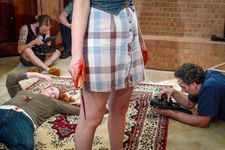 |
| The Brilliant Terror Photo: courtesy of Frightfest |
Were those people doing it just because they loved it and wanted to tell their stories, or were they hoping to make it big?
“I would say it's a combination. Some people are really just in it because they love it. A lot of them have day jobs and then they do this on the side or they do this at night. Then there there are others who are like Jeremiah Kipp, who is a really strong director, and that's his day job as well. Actually, his movie [Slapface] is showing at Frightfest as well, which we're really thrilled about.”
So what did they do when they’d acquired all of this footage from all these different places and then they had to put it together and actually make a coherent film out of it?
“I always think observational documentary storytelling is the opposite of regular movie making,” she reflects. “You get all of this footage, you have a loose idea of what you're wanting, then you look at it, and you look for the story and the themes. And you're storyboarding, like on the back, rather than on the front end.
“We have these huge 4x8 boards that we have sticky notes on, that we storyboard through. And the editing process was off and on over the last few years, in between paid gigs. And so in the same way that we're covering these grassroots filmmakers, we're very much grassroots as well, and doing most of it on a shoestring budget. But what I really love is kind of discovering those connections and the stories, and when it comes together, that feels right. It's fascinating to me when you are editing, and just moving like one little thing over here instead of here, either changes the meaning or just emphasises what you want it to.
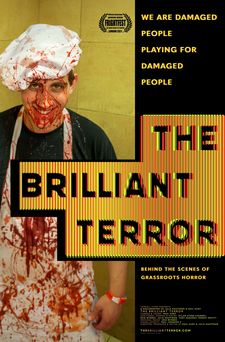 |
| The Brilliant Terror poster Photo: courtesy of Frightfest |
“I think that the advantage of having it be a project that we worked on over several years, coming in and out, is that you learn to let go of your babies and nothing becomes too precious. Even in the last month that we were wrapping things up, we we took out a chunk that was a big element of it, and that just opened things in a different way, and everything slotted into place.”
Does the finished project resemble the expectations she had going into this?
“When we started out, it was going to be a fairly straightforward documentary. And when we discovered Mike and started doing behind the scenes with him, it became more of what our typical style is like and seeing how things unfold. And so we were really happy to see that it became kind of this hybrid of interviews and seeing how things are being made. So we're really happy. How do I say it? We're still entertained by watching our own movie, which is a nice surprise in some ways, because you spend so much time with it. We still laugh at it. We still like our emotional moments. And that makes it easier to put out there.”
Getting into Frightfest was also a nice surprise.
“Oh, we were so thrilled that it got picked up at Frightfest! Actually. We submitted it, like it was the day before the final deadline. We’d just wrapped it up. And we're like, ‘Well, let's, let's give it a try.’ I submitted it to Frightfest, and the that was a Sunday evening. And the Monday morning, there was an email in my inbox. And I was like, ‘What's this?’ And it was from Alan Jones, asking if we would like to show our movie at Frightfest.” She laughs, clearly still enjoying that moment. “Nothing ever happens like that! I didn't expect to hear for a month or anything. And he had lovely things to say about it. Paul and I were walking around asking ‘What's going on? Is this real?’ It was so much fun.”
As well as promoting this film, they’re looking at the possibility of a future documentary about Rob Bottin, the special effects wizard behind John Carpenter’s The Thing. We’ll look forward to it.
The Brilliant Terror screens at Frightfest tonight, 26 August, and will also be available as part of the festival’s online edition at the start of September.





















